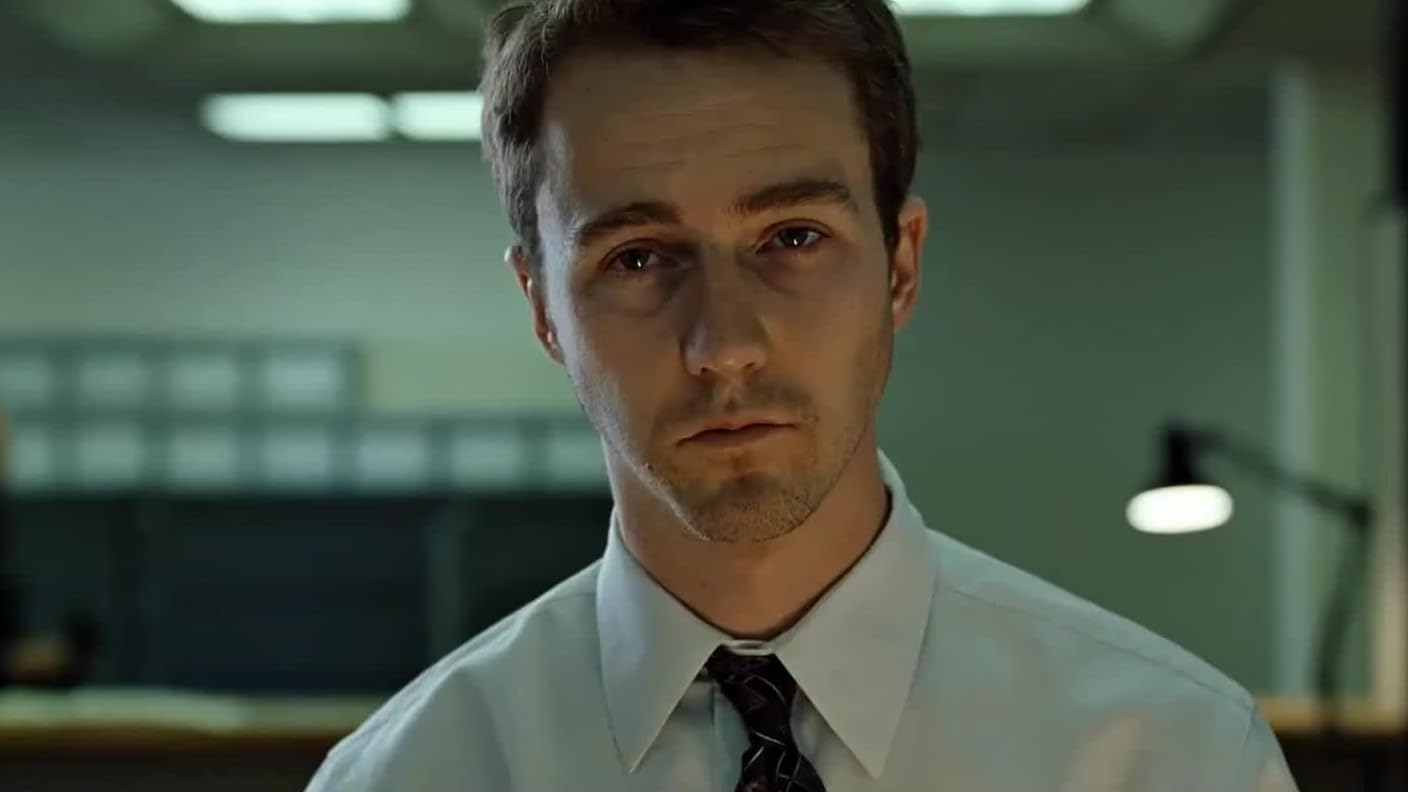Chronic Insomnia in Fight Club

Exploring Sleep Deprivation and the Dissolution of Self
In David Fincher’s “Fight Club,” we witness perhaps cinema’s most compelling exploration of how profound sleep deprivation can fracture human consciousness.
The film’s protagonist, known only as “The Narrator,” traverses a landscape of increasing psychological dissolution. His grip on reality erodes with each sleepless night until his psyche splits, manifesting Tyler Durden—a separate personality embodying everything the narrator believes he cannot be.
The Neuroscience of Disintegration
Recent research in sleep science reveals striking parallels between the film’s depiction of psychological fragmentation and actual neurological processes occurring during extended sleep deprivation.
Researchers have documented how prolonged insomnia creates distinct patterns of neural dysfunction that can lead to experiences of depersonalization and derealization.
The Dissolution of Default Mode Network
During long-term sleep loss, the brain’s default mode network (DMN)—crucial for our sense of self-continuity—gradually degrades its functional connectivity. This deterioration mirrors the protagonist’s gradual loss of a unified sense of self, providing a neurological basis for his experience of psychological fragmentation.
Jungian Shadows in Sleepless Nights
From a Jungian perspective, Tyler Durden represents the classic emergence of the Shadow archetype, but with a fascinating twist – his manifestation is facilitated by the neurological disruption of chronic insomnia. Jung’s concept of the Shadow as the repository of repressed aspects of self finds literal expression in the film’s narrative structure.
The Shadow’s Emergence
The narrator’s inability to sleep creates what Jungian analyst James Hollis terms “the perfect storm” for Shadow integration – or, in this case, disintegration:
- Weakened Ego Boundaries Sleep deprivation erodes the psychological barriers that typically contain Shadow material, allowing repressed content to emerge into consciousness.
- Amplified Compensation The exhausted psyche compensates for perceived inadequacies by manifesting their opposite – Tyler embodies everything the narrator believes he lacks.
- Temporal Discontinuity Disrupted sleep patterns create gaps in conscious awareness that the psyche fills with Shadow material, explaining Tyler’s initial appearances during the narrator’s blackout periods.
Buddhist Psychology: The Multiplicity of Self
Buddhist psychological frameworks offer a particularly illuminating perspective on the narrator’s experience. Unlike Western psychology, which emphasizes the singularity of ego, Buddhist psychology recognizes what’s called “anatta” or “no-self”—the understanding that what we experience as a singular self is a collection of aggregates, or “skandhas.”
This multiplicity of identities was famously articulated within the Bible. When Jesus wandered the desert and came upon the madman, Jesus asked, “Who are you?” When this vessel of insanity replied, “I am LEGION!” Jesus finally understood the fragile nature of the human personality.
The Five Buddhist Skandhas in Fight Club
- Form (Rūpa)
- The narrator’s physical deterioration through sleep deprivation
- Tyler’s manifestation as a separate bodily presence
- The physical transformation of both personalities
- The embodiment of different aspects of consciousness
- Sensation (Vedanā)
- His increasing inability to distinguish between pain and pleasure
- The blurring of sensory experiences
- The altered perception of time and space
- The dissolution of normal pleasure-pain boundaries
- Perception (Saññā)
- The blurring of reality and hallucination
- Altered states of consciousness
- Fragmented memory formation
- Disrupted sensory processing
- Mental Formations (Saṅkhāra)
- Tyler emerged as a separate thought construct (Egregore).
- The development of complex behavioral patterns
- The creation of Fight Club itself
- The manifestation of repressed desires
- Consciousness (Viññāṇa)
- The fragmenting of unified awareness
- The emergence of parallel consciousness streams
- The integration and disintegration of awareness
- The ultimate recognition of multiplicity
Zen Perspectives on Identity Dissolution
Zen Buddhist psychology offers additional insights through its “mu” or emptiness concept. The narrator’s experience can be seen as an involuntary koan – a paradoxical situation that reveals the fundamental emptiness of fixed identity. His journey mirrors what Zen practitioners sometimes experience during intensive meditation retreats:
- Initial Identity Dissolution
- The breaking down of ego boundaries
- The emergence of suppressed aspects of self
- The recognition of identity as a construct
- The experience of fundamental emptiness
- Subsequent Integration
- The recognition of multiplicity within unity
- The acceptance of the paradox
- The transcendence of dual identity
- The emergence of integrated awareness
Mindfulness and Dissociation
Buddhist mindfulness practices offer insights into how awareness can fragment and reintegrate:
- The Observer Effect
- The development of meta-awareness
- The recognition of multiple mind states
- The witness consciousness phenomenon
- The integration of disparate experiences
- The Nature of Consciousness
- The recognition of consciousness as a process
- The understanding of identity as fluid
- The acceptance of multiple self-states
- The integration of paradoxical experiences
Clinical Parallels: Real-World Cases
The film’s depiction of sleep-deprivation-induced psychosis finds numerous parallels in clinical literature. Dr. Ohad Nave‘s extensive case documentation reveals patterns of identity dissolution that mirror the film’s narrative in striking ways:
Case Study: The Executive’s Divide
A high-powered corporate executive experiencing severe chronic insomnia began noticing periods where she would “become someone else” – a more aggressive, risk-taking version of herself who would make significant business decisions she couldn’t later recall. EEG studies during these episodes showed distinct patterns of frontal lobe dysfunction similar to those observed in Fight Club’s protagonist.
Case Study: The Artist’s Echo
A contemporary artist documented his experience of progressive sleep deprivation, describing the emergence of what he called his “night self” – a separate personality that would produce artworks in styles radically different from his regular work. Neuroimaging revealed altered connectivity patterns in his default mode network during these creative episodes.
Case Study: The Programmer’s Parallel
A Silicon Valley programmer, working through extended periods of sleep deprivation, developed what colleagues described as two distinct working styles. His “day code” was methodical and well-documented, while his “night code” showed brilliant but chaotic innovation. Sleep studies revealed severe disruption of his slow-wave sleep patterns, correlating with periods of personality splitting.
Case Study: The Writer’s Duality
A novelist experiencing chronic insomnia reported writing entire chapters in styles drastically different from her usual voice. Analysis revealed these episodes occurred during periods of severe sleep debt, with manuscript timestamps showing consistent patterns of nocturnal activity she couldn’t recall.
Case Study: The Trader’s Transformation
A financial trader developed what he termed his “market warrior” personality during periods of extreme sleep deprivation. This alternate self demonstrated remarkably different risk tolerance and decision-making patterns, leading to spectacular gains and losses he couldn’t explain later.
The Existential Dimension
From an existential perspective, Fight Club’s exploration of fragmented consciousness raises profound questions about the nature of the authentic self. The narrator’s journey can be seen as an extreme manifestation of what existential philosophers call “bad faith”—the psychological splitting that occurs when we cannot reconcile different aspects of our being.
Sartre’s Looking Glass
Jean-Paul Sartre’s concept of “being for itself” versus “being in itself” is vividly expressed in the narrator’s struggle. Tyler represents the narrator’s attempt to resolve the fundamental tension between these modes of being by creating a separate self unbound by social constraints.
Heidegger’s Authenticity
Martin Heidegger‘s concept of “authentic existence” provides another lens through which to view the narrator’s psychological splitting:
- The Call to Authenticity
- The rejection of societal roles
- The questioning of conventional existence
- The search for genuine self-expression
- The confrontation with mortality
- Anxiety as Revelation
- The recognition of existential dread
- The emergence of suppressed possibilities
- The confrontation with nothingness
- The transformation through crisis
Kierkegaard’s Despair
Søren Kierkegaard’s analysis of despair illuminates the narrator’s condition:
- Despair of the Finite
- The rejection of societal limitations
- The desire for infinite possibility
- The creation of an idealized self
- The revolt against finitude
- Despair of the Infinite
- The loss of concrete identity
- The dissolution of practical boundaries
- The fragmentation of self
- The terror of unlimited possibility
Nietzsche’s Übermensch
Tyler Durden can be seen as a manifestation of Nietzsche’s concept of the Übermensch:
- Transcendence of Social Norms
- The rejection of conventional morality
- The creation of new values
- The embrace of chaos
- The will to power
- The Price of Transformation
- The necessity of destruction
- The pain of growth
- The danger of self-overcoming
- The risk of madness
Existential Therapy Perspectives
Modern existential therapy offers insights into the narrator’s condition:
- The Role of Anxiety
- Anxiety as a catalyst for change
- The recognition of the possibility
- The confrontation with freedom
- The necessity of choice
- The Search for Meaning
- The rejection of societal meaning
- The creation of personal meaning
- The integration of shadow aspects
- The development of authentic self
- The Integration of Multiplicity
- The acceptance of contradictions
- The synthesis of opposing forces
- The development of a flexible identity
- The embrace of complexity
Philosophical Implications
The film’s exploration of fractured consciousness raises fundamental questions about the nature of identity and consciousness:
- If consciousness can split through sleep deprivation, what does this tell us about its fundamental nature?
- How do we reconcile Buddhist concepts of no-self with Western therapeutic approaches focused on integration?
- What role does sleep play in maintaining the illusion of a unified self?
Conclusion:
In closing, it must be noted that present-day quantum physics has nearly proved that the collective projection of our so-called reality, human individuation, and indelible spiritual self is nowhere near as solid as we have believed. The Buddhist belief of impermanence, i.e. that everything is in perpetual change, nothing is solid, and resistance to this universal law is the sole generator of our suffering.
Someone once said, ‘If you’re in an impossible situation with no apparent exit, the only way out is to go deeper within.
References:
- Severe Sleep Deprivation Causes Hallucinations and a Gradual Progression Toward Psychosis With Increasing Time Awake. https://pmc.ncbi.nlm.nih.gov/articles/PMC6048360/#:~:text=Studies%20in%20schizophrenia%20and%20bipolar,insomnia%20(8%E2%80%9312).
- The Effects of Sleep Loss on Psychotic Experiences Tested in an Experimental Study. https://academic.oup.com/schizophreniabulletin/article/44/3/662/4065373
- From Self to Nonself: The Nonself Theory. https://pmc.ncbi.nlm.nih.gov/articles/PMC4740732/
-
My name is Legion; for We Are Many. https://gospelstudy.us/my-name-is-legion-for-we-are-many/?srsltid=AfmBOoprCuDf-hDVBGVPnWIVJJcsvDsfk37Wuuij0Jy4C9Hl6M3NMV4x

